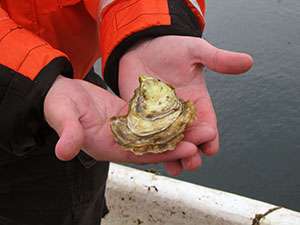Aquatic Farming Permit FAQs

- What is Aquatic Farming?
Aquatic Farming is the act of operating a facility that grows, farms, or cultivates farm products in captivity or under positive control. Aquatic farm products may include aquatic plants, shellfish, crustaceans, mollusk, or other invertebrates that is indigenous to state waters or is authorized to be imported into the state under a permit issued by the commissioner, that is propagated, farmed, or cultivated in an aquatic farm and sold or offered for sale. Finfish farming is prohibited.
- What is required in order to operate an aquatic farm site?
Alaska law requires that any person must be permitted to engage in aquatic farming activities such as operating an aquatic farm site, to possess seedstock, to plant seed on your leased land, and to harvest market size aquatic farm product on the leased site. A person must first apply for a tideland aquatic farm lease with the Department of Natural Resources (DNR) and an aquatic farm operation permit with Alaska Department of Fish & Game (ADF&G) by using a joint-agency aquatic farm program application. A signed lease agreement is required for aquatic farms on state lands before an operation permit is issued. For more information of aquatic farm requirements in Alaska, please refer to ADF&G Aquatic Farming Permitting Requirements.
- How do I apply for an aquatic farm site and what does it cost?
You may apply for an Aquatic Farm Operation Permit by completing a Joint-Agency Aquatic Farm Program application form and submitting it to the Department of Natural Resources. An application-processing fee is required to be submitted to DNR along with the completed joint-agency application.
For aquatic farm projects proposing to use the intertidal or subtidal areas for on-bottom culture, ADF&G requires that a survey of species intended for culture be conducted, in order to determine the initial abundance at the site. The fee for a subtidal on-bottom culture aquatic farm site survey is $5,000 per site and for an intertidal on-bottom culture aquatic farm site survey is $2,000 per site. This survey fee must be submitted with application packet.
For more information about how to apply and fee structure, please refer to ADF&G Aquatic Farming Permitting Requirements.
- When can I apply?
An application opening period is scheduled every year from January 1 through April 30.
Public notices of the application filing period are posted online on the DNR's web site and are also published in various newspapers throughout the state. You may also ask the DNR Aquatic Farm Program Manager to place your name on the aquatic farm mailing list so you will be notified of future openings.
- How long will it take before I can start farming?
ADF&G has 30 days to make a decision on an application after ADNR has issued a lease. If you submitted a joint agency application, no further action is required. The DNR leasing process can take 1-2 years depending on complexity of the project and completeness of the application. Other authorizations that may be required to operate are with US Army Corps of Engineers, local or city governments, Special Area Permits in critical habitat areas and permits with ADEC. Please refer to the NOAA Permitting Portal for additional information.
- What kinds of shellfish and marine plants are being raised in Alaska?
Primarily Pacific oysters (Crassostrea (Magallana) gigas), blue mussels (Mytilus trossolus), geoduck (Panopea generosa), bull kelp (Nereocystis leutkeana), sugar kelp (Saccharina latissima,), and ribbon kelp (Alaria Marginata). There are other shellfish, invertebrate and aquatic plant species being cultivated in smaller quantities.
- Where do I get seed?
Hatcheries spawn adult shellfish and produce microscopic spat. Aquatic farm facilities with nursery equipment can grow spat to a large enough size for shellfish farmers to place in aquatic farm gear or for on-bottom culture. Seed sources from outside of Alaska must be certified disease free. Sources from within the State of Alaska are approved distributors by the state Fish Pathology Lab. Seed of indigenous species to be cultured at an aquatic farm site must come from within the State.
There are a number of hatcheries that produce aquatic plant seeded line for farms. Farmers need to work with their chosen hatchery to ensure that the particular species and stock is acquired for production specific to their site.
A list of approved seed providers that can supply stock to permitted aquatic farming operations can be found on the Seed Source list page. Personal gardening is not allowed in Alaska. For more information on the requirements on how to become a seed source provider in Alaska see our Seed Provider information webpage.
- What are my requirements as a farmer?
Every aquatic farmer must file an annual report by January 31 to fulfill the requirements of both Departments of Natural Resources (DNR) and Fish and Game. The annual report is used to monitor the development and production of your aquatic farm site as authorized by both agencies and to ensure that you are meeting all requirements.
In order to maintain your tidal or subtidal land lease with the Department of Natural Resources, you must meet the commercial use requirement of the lease. The commercial use requirement is dependent on the acreage of the lease. More information can be found at the DNR website.
Depending on culture type, aquatic farms may have other reporting requirements. Please refer to the aquatic farming reporting requirements section of our website for more information.
- How can I get more information?
Please refer to the Aquatic Farm Requirements page for a listing of the main agencies that oversee the aquatic farm industry in Alaska, or contact us.
